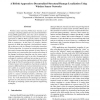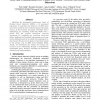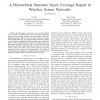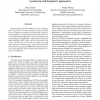RTSS
2008
IEEE
14 years 9 months ago
2008
IEEE
—Energy consumption continues to be a major concern in multiple application domains including powerhungry data centers, portable and wearable devices, mobile communication device...
RTSS
2008
IEEE
14 years 9 months ago
2008
IEEE
Wireless sensor networks (WSNs) have become an increasingly compelling platform for Structural Health Monitoring (SHM) applications, since they can be installed relatively inexpen...
RTCSA
2008
IEEE
14 years 9 months ago
2008
IEEE
· Modelling the fundamental performance limits of Wireless Sensor Networks (WSNs) is of paramount importance to understand the behaviour of WSN under worst-case conditions and to...
PIMRC
2008
IEEE
14 years 9 months ago
2008
IEEE
—In wireless sensor networks, in-network aggregation is the process of compressing locally the data gathered by the sensor nodes, so that only the compressed data travel across s...
PIMRC
2008
IEEE
14 years 9 months ago
2008
IEEE
—In this paper, we propose a new control method to cover “holes” in wireless sensor networks. Many applications often face the problem of holes when some sensor nodes are dis...
PIMRC
2008
IEEE
14 years 9 months ago
2008
IEEE
—We extend the existing network utility maximization (NUM) framework for wired networks to wireless sensor networks by formulating it in order to take into account interference a...
NTMS
2008
IEEE
2008
IEEE
MASA: End-to-End Data Security in Sensor Networks Using a Mix of Asymmetric and Symmetric Approaches
14 years 9 months ago
Wireless Sensor Networks (WSNs) are a new technology that is expected to be used increasingly in the near future due to its cheap cost and data processing ability. However, securi...
MUE
2008
IEEE
14 years 9 months ago
2008
IEEE
Investigating realistic simulations in wireless sensor networks has been an area which has drawn a lot of research interest. These simulations are used to predict the lifetime of ...
MOBIQUITOUS
2008
IEEE
14 years 9 months ago
2008
IEEE
SMEPP Light is a middleware for Wireless Sensor Networks (WSNs) based on mote-class sensors. It is derived from the specification developed under the framework of the SMEPP proje...
LCN
2008
IEEE
14 years 9 months ago
2008
IEEE
—Networked sensors and actuators for purposes from production monitoring and control to home automation are in increasing demand. Until recently, the main focus laid on wired sys...





